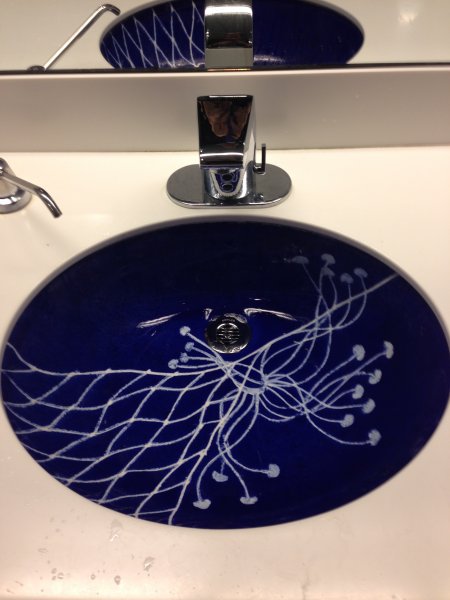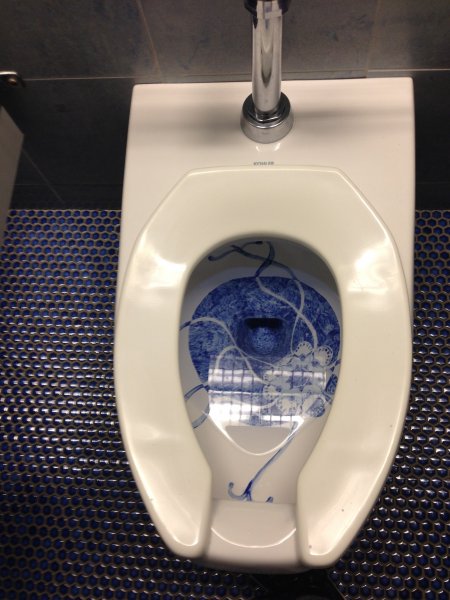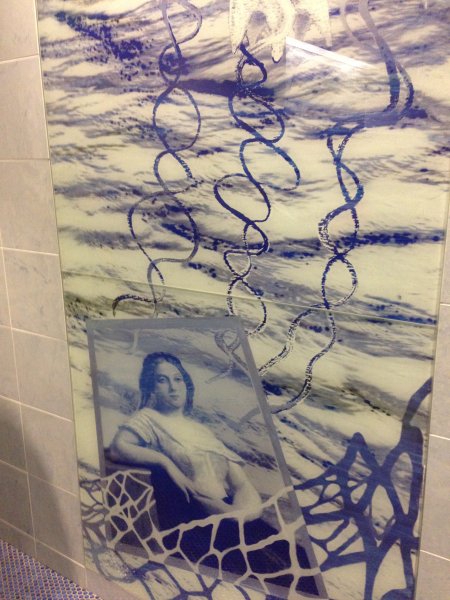 For a house that started off as two rooms in 1728, the Bush-Holley House has had a remarkable history since. You know that I’m now a docent at the Florence Griswold House and Museum, which tells the story of the Lyme Art Colony. Well, this house shows off a concurrent art colony, also of American Impressionists, who gathered in the Cos Cob section of Greenwich, only one hour by train from Manhattan.
For a house that started off as two rooms in 1728, the Bush-Holley House has had a remarkable history since. You know that I’m now a docent at the Florence Griswold House and Museum, which tells the story of the Lyme Art Colony. Well, this house shows off a concurrent art colony, also of American Impressionists, who gathered in the Cos Cob section of Greenwich, only one hour by train from Manhattan.
But the house tells quite a story before then. The original Bush who bought the house didn’t live in it. His son David moved in around 1755 with his wife Sarah. She died in 1776, while the British were running raids in Cos Cob and all around the Bush House. Most of the settlement was burned, but not this Saltbox house.
 You’ve probably guessed why. Yep, David Bush was a suspected Loyalist and was imprisoned as such. After all, his trade with the New York Colony centered on imported goods. The wallpaper in his house was even imported, demonstrating his wealth. During restoration, the stamp was uncovered. Paper goods were stamped when the taxes were paid, a result of the reviled Stamp Act that so angered the rebellious colonists.
You’ve probably guessed why. Yep, David Bush was a suspected Loyalist and was imprisoned as such. After all, his trade with the New York Colony centered on imported goods. The wallpaper in his house was even imported, demonstrating his wealth. During restoration, the stamp was uncovered. Paper goods were stamped when the taxes were paid, a result of the reviled Stamp Act that so angered the rebellious colonists.
Bush’s political troubles didn’t stop from marrying another Sarah, and together, they combined a household with 11 children from previous marriages. Then they added 5 more of their own. This was one crowded house.
 Crowded with slaves, too. To run the farm, Bush had slaves who lived in the barn and more that lived above the kitchen. Convenient, perhaps warm, but clearly spartan. This is a curator’s best guess of how the slaves lived. Like so many others, their stories are lost to memory.
Crowded with slaves, too. To run the farm, Bush had slaves who lived in the barn and more that lived above the kitchen. Convenient, perhaps warm, but clearly spartan. This is a curator’s best guess of how the slaves lived. Like so many others, their stories are lost to memory.
Greenwich was sometimes part of the New York Colony, the last northern colony to abolish slavery, and sometimes part of Connecticut. The Connecticut colony had a complex legislative history around slavery. In 1788, the slave trade was abolished in Connecticut, just after the 1784 Gradual Emancipation Act. Slaves born after 1784 would be emancipated when they turned 25, later lowered to 21. Born in 1783, you’re out of luck. In 1825, Greenwich recorded its last slave.
The Bush family took their slaves to church, and religious beliefs may have informed the decision to emancipate their slaves and support them in buying property. Yet the 1799 will of David Bush listed the slave property and their worth. Connecticut had about 2650 slaves and 2175 free blacks. What a complex of scenarios.
By 1848, bad business decisions forced the Bush descendants to sell the house. Two families attempted to run a boardinghouse in this convenient location, only two blocks from the New York train. It must have been tough-going, because the Holley’s rented the house from the bank, later purchasing it.
Fortunately, they valued the heritage in the house and preserved its Colonial quirks.
They also managed to make a successful boarding house for artists, just like Florence Griswold further up the Connecticut coast. See Elmer McCrae, artist, married a Holley daughter, Constant. He brings the friends, she becomes the gracious hostess and flower arranger extraordinaire. Look at the kind of table she set for the holidays. Nothing like the spartan accommodations of Flo Gris.

Childe Hassam, The Mantle Piece, 1912; in the Best Room, supposedly painted on a cigar box lid
Childe Hassam summered at, and starred at, both boarding houses. He got the “Best Room” at the Bush-Holley House, paying a handsome $20 per week for room and board, compared to $4-8 for the other rooms and $7 at the Flo Gris. The house is full of paintings and etchings he made while staying in the house, of the house and the Best Room.

Childe Hassam, Clarissa (one of the twins) 1912, painted in the entry way of the house

Elmer MacRae, Constance Feeding the Ducks, 1912; exhibited at the Armory Show, 1913
But it’s MacRae’s work that charms many of the walls. His twin daughters, born in 1904, were the frequent subject. After helping organize the 1913 Armory Show, which brought European contemporary art to New York, his style started to change.
Without the commercial success of a Hassam, who was remunerated for repeatedly painting familiar scenes, MacRae had more freedom to experiment.
He worked in pastel and oil, carved wood screens, and the house has a piece of furniture he painted that I wanted to take home.
Willa Cather and other literary elites from New York stayed at the house, too. Cather wrote the Cos Cob section of Song of the Lark, based on her time here.
The Holley family remained in the house until it was turned over to the Greenwich Historical Society in the 1950s, which is why its delights are so intact. With a history like this, it’s really a must-see among the bounty of evocative historic homes in Connecticut.










































































































 And the noise. Perhaps the most evocative part of the day was hearing just a few weaving machines running at
And the noise. Perhaps the most evocative part of the day was hearing just a few weaving machines running at 

 James McNeil Whistler
James McNeil Whistler



 made the long march to Virginia.
made the long march to Virginia. During our breaks, as the soldiers wiped their brows (it was hot for them in their uniforms, even as they were a bit tattered providing natural ventilation), they argued over rum rations and whether rum was the “devil’s drink” or a “likeable thing” and how sugar was tied to slavery. “You don’t like that, do you?” They teased one of the cohort for being from Dela-where? I interjected that I liked Delaware. “That makes two of you,” another shot back.
During our breaks, as the soldiers wiped their brows (it was hot for them in their uniforms, even as they were a bit tattered providing natural ventilation), they argued over rum rations and whether rum was the “devil’s drink” or a “likeable thing” and how sugar was tied to slavery. “You don’t like that, do you?” They teased one of the cohort for being from Dela-where? I interjected that I liked Delaware. “That makes two of you,” another shot back.
 But her art forays seemed to be subsumed, like so many other women artists, by the rigors of her daily life. Now, let us not be confused. Although she and her husband started out fairly modestly, with his lion-like courtroom successes, they soon amassed enough money to buy
But her art forays seemed to be subsumed, like so many other women artists, by the rigors of her daily life. Now, let us not be confused. Although she and her husband started out fairly modestly, with his lion-like courtroom successes, they soon amassed enough money to buy 


 One of the juicy stories told on the tour at her
One of the juicy stories told on the tour at her


 Next time you’re wandering in the Berkshires, I recommend a stop at the
Next time you’re wandering in the Berkshires, I recommend a stop at the 



































